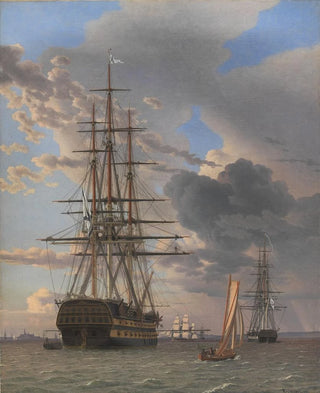Art print of the Russian battleship Asow and a frigate at anchor near Elseneur - Christoffer Wilhelm Eckersberg


View from behind

Frame (optional)
Russian Line Ship Asow and an anchored frigate near Elseneur - Christoffer Wilhelm Eckersberg – Captivating Introduction
In the fascinating universe of maritime painting, the work of Christoffer Wilhelm Eckersberg, "Russian Line Ship Asow and an anchored frigate near Elseneur," stands out for its ability to capture not only the beauty of ships but also the very essence of a bygone era. This artwork, created in the 19th century, evokes a scene of majestic calm where water and sky meet in perfect harmony. The artist, often regarded as the father of Danish realism, invites us to immerse ourselves in a suspended moment, where time seems to stand still. The depiction of ships, emblematic of Russia's naval power, bears witness to a time when the sea was both a source of wealth and danger.
Style and uniqueness of the work
Eckersberg distinguishes himself through his meticulous approach and keen sense of detail. In this piece, he manages to balance realism with romantic aesthetics, creating an atmosphere that is both serene and dynamic. The reflections on the water, rendered with astonishing precision, seem almost tangible, while the clouds, painted with an ethereal lightness, add an almost poetic dimension to the scene. The composition is carefully orchestrated, with each element placed to guide the viewer’s eye across the painting. The colors, subtly nuanced, evoke natural light, enhancing the sense of tranquility emanating from the artwork. This marriage of technique and sensitivity makes this painting an emblematic example of Eckersberg’s talent.
The artist and his influence
Christoffer Wilhelm Eckersberg, born in 1783, played a decisive role in the development of Danish art in the 19th century. Trained at the Royal Danish Academy of Fine Arts in Copenhagen, he was also influenced by his travels in France, where he mingled with the great masters of his time. His work is characterized by a deep respect for nature and a desire to depict the world as it is. Eckersberg successfully integrated elements of European artistic tradition while

Matte finish

View from behind

Frame (optional)
Russian Line Ship Asow and an anchored frigate near Elseneur - Christoffer Wilhelm Eckersberg – Captivating Introduction
In the fascinating universe of maritime painting, the work of Christoffer Wilhelm Eckersberg, "Russian Line Ship Asow and an anchored frigate near Elseneur," stands out for its ability to capture not only the beauty of ships but also the very essence of a bygone era. This artwork, created in the 19th century, evokes a scene of majestic calm where water and sky meet in perfect harmony. The artist, often regarded as the father of Danish realism, invites us to immerse ourselves in a suspended moment, where time seems to stand still. The depiction of ships, emblematic of Russia's naval power, bears witness to a time when the sea was both a source of wealth and danger.
Style and uniqueness of the work
Eckersberg distinguishes himself through his meticulous approach and keen sense of detail. In this piece, he manages to balance realism with romantic aesthetics, creating an atmosphere that is both serene and dynamic. The reflections on the water, rendered with astonishing precision, seem almost tangible, while the clouds, painted with an ethereal lightness, add an almost poetic dimension to the scene. The composition is carefully orchestrated, with each element placed to guide the viewer’s eye across the painting. The colors, subtly nuanced, evoke natural light, enhancing the sense of tranquility emanating from the artwork. This marriage of technique and sensitivity makes this painting an emblematic example of Eckersberg’s talent.
The artist and his influence
Christoffer Wilhelm Eckersberg, born in 1783, played a decisive role in the development of Danish art in the 19th century. Trained at the Royal Danish Academy of Fine Arts in Copenhagen, he was also influenced by his travels in France, where he mingled with the great masters of his time. His work is characterized by a deep respect for nature and a desire to depict the world as it is. Eckersberg successfully integrated elements of European artistic tradition while
12,34 €






